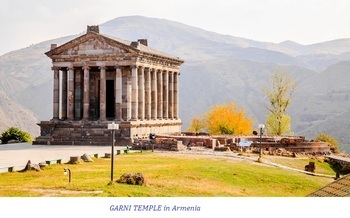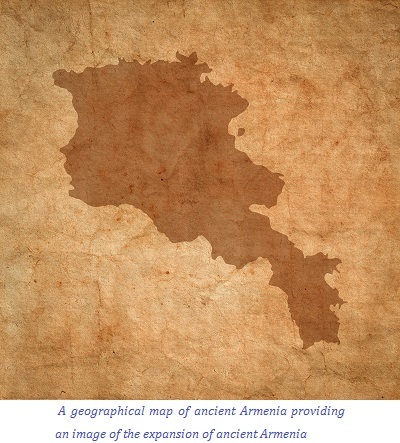

Ancient Armenia followed Prehistoric Armenia, lasting 1,000 years until the Kingdom of Urartu collapsed.  Then, the first Armenian geopolitical organization was established.
Then, the first Armenian geopolitical organization was established.
The term "ancient Armenia" describes Armenia's past, which refers to antiquity. It spans over a long time like Prehistoric Armenian history, beginning after the Iron Age. Later the events led to the fall of the Iron age Kingdom, also a geographical region, famously known as Urartu and the development of the first Armenian geopolitical framework in the sixth century B.C.
Ancient Armenia’s rise as a prominent power in Western Asia in the 4th century B.C. is one of the most significant historical developments of this time period.
The region once known as Urartu (named Bianili by the ancient Assyrians), became home to a multitude of tribe alliances and kingdoms throughout the Iron Age. Peoples including Shupria, Nairi, Mushki, Hayasa-Azzi, and maybe even a community later termed as the Armeno-Phrygians, all belonged to this group. Some of the fascinating information about ancient Armenia are as follows −
To protect the hills from Assyria, individuals from the Lake Van region founded the Kingdom of Van (Urartu) in ninth century B.C., which started cultural absorption by uniting the territory's many peoples under a single monarchy.
In the sixth century B.C, the kingdom was conquered by the invading Medes. Shortly after, the area of the conquered kingdom gave origin to the modern country of Armenia.
Because of the rise of Armenian nationalism in the region, Urartu's legacy began to fade.
The Kingdom of Armenia was bounded in the east by Albania in the Caucasus, in the north by Spain, in the west by the Roman Empire, and in the south by Parthia and the Sassanian Empire. The Kur River served as both the eastern and western borders of the Kingdom of Armenia, separating Iberia and Caucasian Albania.
After 331 B.C.E., Armenia was split into the kingdoms of Armenia (modern-day Armenia Major), Sophene (Armenia Minor), and Pontus (Lesser Armenia). Many neighbouring kingdoms (Media, Caucasian Iberia, and the Seleucid Empire) took advantage of Artaxias I's weak position to seize the kingdom's outlying regions shortly after his tenure began in 189 B.C.
Many neighbouring kingdoms (Media, Caucasian Iberia, and the Seleucid Empire) took advantage of Artaxias I's weak position to seize the kingdom's outlying regions shortly after his tenure began in 189 B.C.
According to Strabo, Caspiane and Paytakaran were reunited after a campaign led by King Artaxias I. His grandson Tigranes the Great was successful in unifying Lesser Armenia, Corduene, and Sophene, but he was unable to accomplish so because of conflicts between the Seleucid kingdom and Artaxias I. He triumphed against the Iberians in the north, and he unified Gugark.
After the partition of the Roman Empire and the Sassanid dynasty’s sudden rise in Persia, Armenia was in the forefront during the fight between these two powers. Later when Shapur III and Theodosius I divided Armenia into Byzantine Armenia and Sasanian Armenia, ancient Armenian history came to an end and Medieval Armenia began.
After the Orontid dynasty started ruling Armenia, it saw several conflicts and changes for a long time. Some changes the then Armenia saw are mentioned below −
At about 570 B.C., Ancient Armenia became a monarchy under the Orontid dynasty, but by 553 B.C., it had become a Persian “satrapy”. At this time, several Armenian rebellions and conflicts against the Persian Empire broke out.
Orontes III and Mithridates, who had previously controlled the Armenian satrapy, declared independence and established the realms of Armenia and Lesser Armenia. Also, Orontes III was able to defeat the Thessalian general Menon, who had been attempting to seize control of the Sper gold mines.
Last king of the Orontid dynasty, Orontes IV, was deposed by Artaxias (Artashes) I, a general in the Seleucid Empire who some historians think had ties with the Orontids. This occurred in 200/201 B.C.
Tigranes II, king of Armenia, led an invasion and defeated the Seleucid Empire. He created an independent state that spanned from the Caspian Sea on the east side and the Mediterranean Sea at the west side while the Roman Empire expanded to the east. So, the Romans rapidly destroyed Tigranes' monarchy. From then the future Armenian kings governed as clients of the Roman Empire.
When the Armenian empire collapsed, tensions arose between Rome and Parthia over the territory of Armenia. As a result Armenia would spend decades passing through periods of independence, Roman authority, and Parthian supremacy. Once the Romans overthrew the Artaxiad dynasty, the Arsacids (Armenian: Arshakuni) took control of Armenia. The territorial dispute between the Roman and Perthian empires over Armenia did not end with the Arsacid era.
Mark Antony's invasion and subsequent destruction of the kingdom in 34 B.C., after the battle of “Tigranocerta”, placed Armenia under the Ancient Roman sphere of influence. Armenia's previous ally, Pontic King Mithridates VI, had been a friend of the Armenians. Augustus made peace with the Parthians in 20 B.C., positioning Armenia as a neutral zone between the two empires.
Ancient Armenia which went on for more than thousand years had seen several invasions, conflicts and dynasties. From the Artaxiad dynasty to Roman invasion, everything shaped the history of ancient Armenia. It finally ended with Armenia becoming a neutral zone between Parthians and Romans.
Q1. What was the old name for Armenia?
Ans. Hayk was the ancient Armenian name for the nation, which was eventually changed to Hayastan (land of Hayk).
Q2. What changes did Armenia see after the Tigranocerta battle?
Ans. The Romans defeated the TYigrane’s army made of peasants and raw levies, the Romans reclaimed control over Armenia. It marked the beginning of the Roman empire’s rule over Armenia.
Q3. What is Armenia's earliest civilization?
Ans. The earliest known ancestors of contemporary Armenians are the Hayasa-Azzi, an indigenous people who inhabited Mount Ararat and regions of current Turkey.